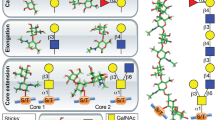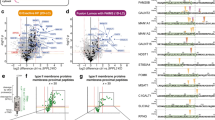Abstract
Xylosylation of core proteins takes place in the Golgi-apparatus as the transfer of xylose from UDP-xylose to specific serine residues in proteoglycan core proteins. This initial and rate-limiting step in glycosaminoglycan biosynthesis is catalyzed by human xylosyltransferase I (XT-I). XT-I is proteolytically cleaved from the Golgi surface and shed in its active form into the extracellular space. The secreted, circulating glycosyltransferase represents a serum biomarker for various diseases with an altered proteoglycan metabolism, whereas a physiological function of secreted XT-I is still unknown. To shed light on the secretion process of XT-I and on its biological function, the cleavage site was examined and the group of proteases involved in the cleavage was identified in this study. The peptide mass fingerprint from partly purified secreted XT-I revealed the cleavage site to be localized in the aminoterminal 231 amino acids. The addition of a cysteine protease inhibitor cocktail to cells recombinantly expressing XT-I led to a concentration-dependent shift of enzyme activity towards the cell lysates attended by consistent total intracellular and extracellular XT-I activities. In conclusion, our findings provide a first insight into the XT-I secretion process regulated by a cysteine protease and may contribute to understanding the biological and pathological role of this process.




Similar content being viewed by others
Abbreviations
- AAA:
-
Abdominal aortic aneurysm
- CRTL:
-
Control
- EC:
-
Extracellular
- IC:
-
Intracellular
- XT:
-
Xylosyltransferase
- XT-I:
-
Xylosyltransferase I
References
Iozzo, R.V.: Matrix proteoglycans: from molecular design to cellular function. Annu. Rev. Biochem. 67, 609–652 (1998)
Kjellen, L., Lindahl, U.: Proteoglycans: structures and interactions. Annu. Rev. Biochem. 60, 443–475 (1991)
Schwartz, N.B.: Regulation of chondroitin sulfate synthesis. Effect of beta-xylosides on synthesis of chondroitin sulfate proteoglycan, chondroitin sulfate chains, and core protein. J. Biol. Chem. 252, 6316–6321 (1977)
Kearns, A.E., Campbell, S.C., Westley, J., Schwartz, N.B.: Initiation of chondroitin sulfate biosynthesis: a kinetic analysis of UDP-D-xylose: core protein beta-D-xylosyltransferase. Biochemistry (Mosc) 30, 7477–7483 (1991)
Joziasse, D.H.: Mammalian glycosyltransferases: genomic organization and protein structure. Glycobiology 2, 271–277 (1992)
Field, M.C., Wainwright, L.J.: Molecular cloning of eukaryotic glycoprotein and glycolipid glycosyltransferases: a survey. Glycobiology 5, 463–472 (1995)
Schön, S., Prante, C., Bahr, C., Kuhn, J., Kleesiek, K., Götting, C.: Cloning and recombinant expression of active full-length xylosyltransferase I (XT-I) and characterization of subcellular localization of XT-I and XT-II. J. Biol. Chem. 281, 14224–14231 (2006)
El-Battari, A., Prorok, M., Angata, K., Mathieu, S., Zerfaoui, M., Ong, E., Suzuki, M., Lombardo, D., Fukuda, M.: Different glycosyltransferases are differentially processed for secretion, dimerization, and autoglycosylation. Glycobiology 13, 941–953 (2003)
Götting, C., Kuhn, J., Kleesiek, K.: Human xylosyltransferases in health and disease. Cell. Mol. Life Sci. 64, 1498–1517 (2007)
Pönighaus, C., Ambrosius, M., Carrera Casanova, J., Prante, C., Kuhn, J., Esko, J.D., Kleesiek, K., Götting, C.: Human xylosyltransferase II is involved in the biosynthesis of the uniform tetrasaccharide linkage region in chondroitin sulfate and heparan sulfate proteoglycans. J. Biol. Chem. 282, 5201–5206 (2007)
Kim, J.J., Conrad, H.E.: Secretion of chondroitin SO4 by monolayer cultures of chick embryo chondrocytes. J. Biol. Chem. 255, 1586–1597 (1980)
Evangelisti, R., Becchetti, E., Baroni, T., Rossi, L., Arena, N., Valeno, V., Carinci, P., Locci, P.: Modulation of phenotypic expression of fibroblasts by alteration of the cytoskeleton. Cell Biochem. Funct. 13, 41–52 (1995)
Rennison, M.E., Handel, S.E., Wilde, C.J., Burgoyne, R.D.: Investigation of the role of microtubules in protein secretion from lactating mouse mammary epithelial cells. J. Cell Sci. 102(Pt 2), 239–247 (1992)
Götting, C., Sollberg, S., Kuhn, J., Weilke, C., Huerkamp, C., Brinkmann, T., Krieg, T., Kleesiek, K.: Serum xylosyltransferase: a new biochemical marker of the sclerotic process in systemic sclerosis. J. Invest. Dermatol. 112, 919–924 (1999)
Götting, C., Kuhn, J., Sollberg, S., Huerkamp, C., Brinkmann, T., Krieg, T., Kleesiek, K.: Elevated serum xylosyltransferase activity correlates with a high level of hyaluronate in patients with systemic sclerosis. Acta Derm. Venereol. 80, 60–61 (2000)
Götting, C., Hendig, D., Adam, A., Schön, S., Schulz, V., Szliska, C., Kuhn, J., Kleesiek, K.: Elevated xylosyltransferase I activities in pseudoxanthoma elasticum (PXE) patients as a marker of stimulated proteoglycan biosynthesis. J. Mol. Med. 83, 984–992 (2005)
Götting, C., Kuhn, J., Kleesiek, K.: Serum xylosyltransferase activity in diabetes mellitus patients as a possible marker of reduced proteoglycan biosynthesis. Diabetes Care 31, 2018–2019 (2008)
Varki, A., Esko, J.D., Colley, K.J.: Cellular Organization of Glycosylation. In: Varki, A., Cummings, R.D., Esko, J.D., Freeze, H.H., Stanley, P., Bertozzi, C.R., Hart, G.W., Etzler, M.E. (eds.) Essentials of Glycobiology. Cold Spring Harbor Laboratory, Cold Spring Harbor (2009)
Esko, J.D., Stewart, T.E., Taylor, W.H.: Animal cell mutants defective in glycosaminoglycan biosynthesis. Proc. Natl Acad. Sci. USA 82, 3197–3201 (1985)
Brinkmann, T., Weilke, C., Kleesiek, K.: Recognition of acceptor proteins by UDP-D-xylose proteoglycan core protein beta-D-xylosyltransferase. J. Biol. Chem. 272, 11171–11175 (1997)
Weilke, C., Brinkmann, T., Kleesiek, K.: Determination of xylosyltransferase activity in serum with recombinant human bikunin as acceptor. Clin. Chem. 43, 45–51 (1997)
Götting, C., Kuhn, J., Brinkmann, T., Kleesiek, K.: Xylosylation of alternatively spliced isoforms of Alzheimer APP by xylosyltransferase. J. Protein Chem. 17, 295–302 (1998)
Lutgens, S.P., Cleutjens, K.B., Daemen, M.J., Heeneman, S.: Cathepsin cysteine proteases in cardiovascular disease. FASEB J. 21, 3029–3041 (2007)
Dickinson, D.P.: Cysteine peptidases of mammals: their biological roles and potential effects in the oral cavity and other tissues in health and disease. Crit. Rev. Oral Biol. Med. 13, 238–275 (2002)
Ascenzi, P., Salvati, L., Bolognesi, M., Colasanti, M., Polticelli, F., Venturini, G.: Inhibition of cysteine protease activity by NO-donors. Curr. Protein Pept. Sci. 2, 137–153 (2001)
Turk, B., Turk, V., Turk, D.: Structural and functional aspects of papain-like cysteine proteinases and their protein inhibitors. Biol. Chem. 378, 141–150 (1997)
Chapman, H.A., Riese, R.J., Shi, G.P.: Emerging roles for cysteine proteases in human biology. Annu. Rev. Physiol. 59, 63–88 (1997)
Turk, B., Turk, D., Turk, V.: Lysosomal cysteine proteases: more than scavengers. Biochim. Biophys. Acta 1477, 98–111 (2000)
Lützner, N., Kalbacher, H.: Quantifying cathepsin S activity in antigen presenting cells using a novel specific substrate. J. Biol. Chem. 283, 36185–36194 (2008)
Choe, Y., Leonetti, F., Greenbaum, D.C., Lecaille, F., Bogyo, M., Brömme, D., Ellman, J.A., Craik, C.S.: Substrate profiling of cysteine proteases using a combinatorial peptide library identifies functionally unique specificities. J. Biol. Chem. 281, 12824–12832 (2006)
Acknowledgements
The authors thank Xiaoping Xu and Gudrun Bokermann for their excellent technical assistance. In addition, we thank Sarah L. Kirkby for her linguistic advice.
Author information
Authors and Affiliations
Corresponding author
Rights and permissions
About this article
Cite this article
Pönighaus, C., Kuhn, J., Kleesiek, K. et al. Involvement of a cysteine protease in the secretion process of human xylosyltransferase I. Glycoconj J 27, 359–366 (2010). https://doi.org/10.1007/s10719-010-9283-4
Received:
Revised:
Accepted:
Published:
Issue Date:
DOI: https://doi.org/10.1007/s10719-010-9283-4




